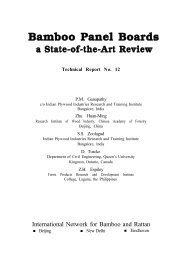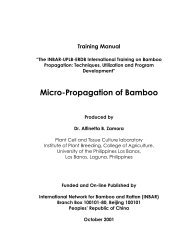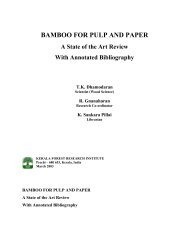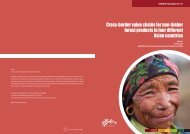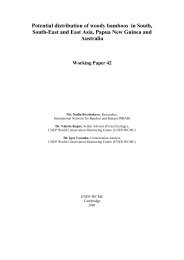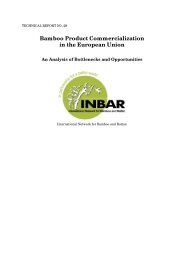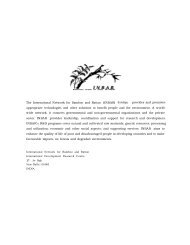The Bamboo and Rattan Sectors in Asia: an Analysis of ... - INBAR
The Bamboo and Rattan Sectors in Asia: an Analysis of ... - INBAR
The Bamboo and Rattan Sectors in Asia: an Analysis of ... - INBAR
Create successful ePaper yourself
Turn your PDF publications into a flip-book with our unique Google optimized e-Paper software.
agencies <strong><strong>an</strong>d</strong> <strong>in</strong>dustry associations to get their view <strong><strong>an</strong>d</strong> perspectives on specific<br />
issues <strong><strong>an</strong>d</strong> problems affect<strong>in</strong>g the <strong>in</strong>dustry. Additionally, secondary <strong>in</strong>formation was<br />
collected as <strong><strong>an</strong>d</strong> where it was available.<br />
<strong>The</strong> summaries here are abstracted from the orig<strong>in</strong>al reports to <strong>INBAR</strong>. This<br />
<strong>in</strong>formation has also been supplemented with data from the current author's field<br />
experiences <strong>in</strong> several <strong>of</strong> the study areas, <strong><strong>an</strong>d</strong> from secondary sources. Altogether six<br />
studies each were carried out <strong>in</strong> both bamboo <strong><strong>an</strong>d</strong> ratt<strong>an</strong> sectors.<br />
<strong>The</strong> <strong>Bamboo</strong> Sector<br />
Extensive <strong>Bamboo</strong> Production-to-Consumption Systems <strong>in</strong> Eastern<br />
Nepal: a Case Study 3<br />
Introduction<br />
<strong>Bamboo</strong> is <strong>in</strong>tegral to the rural economy <strong>of</strong> Nepal. It is used <strong>in</strong> m<strong>an</strong>y applications<br />
<strong>in</strong> construction, fenc<strong>in</strong>g, as food <strong><strong>an</strong>d</strong> fodder, <strong><strong>an</strong>d</strong> as raw material for agricultural<br />
implements, baskets <strong><strong>an</strong>d</strong> other utility items. <strong>Bamboo</strong> is also <strong>in</strong>creas<strong>in</strong>gly import<strong>an</strong>t as<br />
a basis for small enterprises that provide upwards <strong>of</strong> 100 000 workdays <strong>of</strong> employment<br />
<strong>an</strong>nually.<br />
<strong>Bamboo</strong>s are found <strong>in</strong> all three major ecological zones <strong>in</strong> Nepal (Tarai, Mid-hills<br />
<strong><strong>an</strong>d</strong> Mounta<strong>in</strong>s). <strong>The</strong>y are more concentrated <strong>in</strong> the eastern half <strong>of</strong> the country, with<br />
the largest numbers <strong><strong>an</strong>d</strong> variety be<strong>in</strong>g found <strong>in</strong> areas with the highest ra<strong>in</strong>fall. Nepal<br />
has both tropical bamboos typical <strong>of</strong> Southeast <strong>Asia</strong> <strong><strong>an</strong>d</strong> temperate bamboos <strong>of</strong> Tibet<br />
<strong><strong>an</strong>d</strong> Bhut<strong>an</strong>.<br />
This study <strong>in</strong>vestigated the bamboo production-to-consumption system (PCS) <strong>in</strong><br />
three districts <strong>of</strong> the Eastern Tarai Region <strong>of</strong> Nepal ---- Siraha, Saptari <strong><strong>an</strong>d</strong> Udaypur<br />
---- where bamboo is produced extensively both <strong>in</strong> natural forests <strong><strong>an</strong>d</strong> on farms. <strong>The</strong><br />
area has a strong bamboo-based rural enterprise sector, although the local economy<br />
is predom<strong>in</strong><strong>an</strong>tly agricultural with limited opportunities for <strong>of</strong>f-farm employment.<br />
With a high rate <strong>of</strong> population growth (3.0% per year) <strong>in</strong> the region, strategies are<br />
needed to provide livelihood options that do not compete for agricultural l<strong><strong>an</strong>d</strong> or<br />
otherwise affect food production.<br />
<strong>The</strong> bamboo sector appears to <strong>of</strong>fer good potential <strong>in</strong> this area. Recent policy<br />
ch<strong>an</strong>ges have opened the way for <strong>in</strong>creased <strong><strong>an</strong>d</strong> more secure utilization <strong>of</strong> public<br />
l<strong><strong>an</strong>d</strong> by communities. <strong>The</strong>re is a high level <strong>of</strong> subsistence/utility use <strong>of</strong> bamboo <strong><strong>an</strong>d</strong><br />
3 By Madhav Karki (International Development Research Centre, South <strong>Asia</strong>n Regional Office, New<br />
Delhi, India), Gopal Sherch<strong>an</strong> (Forest Research <strong><strong>an</strong>d</strong> Survey Centre, Kathm<strong><strong>an</strong>d</strong>u, Nepal) <strong><strong>an</strong>d</strong> Jaya Bahadur<br />
Karki (Tribhuv<strong>an</strong> University Institute <strong>of</strong> Forestry, Pokhara, Nepal).<br />
11



